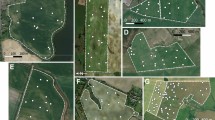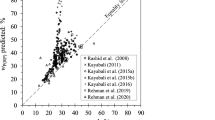Abstract
This paper describes the development of an empirical deterministic two-factor response surface model for the Woodruff lime-requirement buffer (WRF). The model may be used to produce variable-rate lime requirement maps, or to predict lime requirements in real-time. Hence it may be suitable as a component of a decision support system (DSS) for the site-specific management of acid soil. The models' predictions were compared to those of a one-factor response surface, and those of a linear regression. The models tested were validated against soil-CaCO3 incubations using a statistical jackknifing procedure for error and bias estimations. The Akaike Information Criterion (AIC) was used to ascertain the best model in terms of goodness of fit and parsimony. The two-factor response surface model produced the best lime requirement estimates, followed by the single-factor model, then the conventional linear regression. The advantages of the response surface models are their improved prediction accuracy, and their flexibility in the choice of any target pH (from pH 5.5 to 7) without the need for excessive calibrations. The uncertainty of the model was assessed using data from an agricultural field in Kelso, New South Wales, Australia. Block kriged maps of soil pH measured in 0.01 M CaCl2 (pHCaCl2), WRF buffer pH (pHbuffer) and lime requirements to a target pH of 7 were produced, to compare their spatial distributions. Finally the economic and agronomic benefits of site-specific liming were considered.
Similar content being viewed by others
References
R. L. Aitken, P. W. Moody, and P. G. McKinley. Lime requirement of acidic Queensland soils. II. Comparison of laboratory methods for predicting lime requirement. Australian Journal of Soil Research 28, 703-715 1990.
R. L. Aitken, P. W. Woody, and T. Dickson. Field calibration of lime requirement soil tests. In Plant and Soil Interactions at Low pH: Principles and Management-Proceedings of the Third International Symposium on Plant-Soil Interactions at Low pH, edited by R. A. Date, N. J. Grundon, G. E. Rayment, and M. E. Probert Kluwer Academic Publishers, Boston, USA, 1995, pp. 65-70.
H. Akaike. Information theory and an extension of maximum likelihood principle. In Second International Symposium on Information Theory, <nt>edited by</nt> B. N. Petrov and F. Csaki Akademia Kiado, Budapest, Hungary, 1973, pp. 267-281.
S. C. Borgelt, S. W. Searcy, B. A. Stout, and D. J. Mulla. A method for determining spatially variable liming rates. Paper No. 89-1034 American Society of Agricultural Engineers, 1995.
J. R. Brown and J. R. Cisco, An improved Woodruff buffer for estimation of lime requirement. Soil Science Society of America Journal 48, 587-592 1984.
T. M. Burgess and R. Webster. Optimal interpolation and isarithmic mapping of soil properties. II. Block kriging. Journal of Soil Science 31, 333-341 1980.
D. R. Coventry, W. J. Slattery, V. F. Burnett, and G. W. Ganning. Longevity of wheat yield response to lime in south-eastern Australia. Australian Journal of Experimental Agriculture 37, 571-575 1997.
B. Efron and R. J. Tibshirani. An introduction to the bootstrap. Monographs on Statistics and Applied Probability, vol. 57 Chapman and Hall Inc., Boston, USA, 1993.
E. J. Evans, R. S. Shield, and S. B. Mohamed. Optimisation of lime application to take account of within-field variation in pH and soil texture. In Precision Agriculture '97, Proceedings of the 1st European Conference on Precision Agriculture, vol. I: Spatial Variability in Soil and Crop, <nt>edited by</nt> J. V. Stafford BIOS Scientific Publishers, Ltd., Oxford, UK, 1997, p. 103.
K. Gustafsson. Models for precision application of lime. In Precision Agriculture '99, Proceedings of the 2nd European Conference on Precision Agriculture Part. I', <nt>edited by</nt> J. V. Stafford Sheffield.Academic Press, UK, 1999, pp. 175-180.
D. R. Keeney and R. B. Corey. Factors affecting the lime requirement of Wisconsin soils. Soil Science Society of America Proceedings 27, 277-280 1963.
W. E. Larson and R. C. Robert. Farming by soil. In Soil Management for Sustainability, <nt>edited by</nt> R. Lal and F. J. Pierce Soil Water Conservation Society, Ankeny, IO, USA, 1991, p. 103-112.
G. M. Laslett, A. B. McBratney, P. J. Pahl, and M. F. Hutchinson. Comparison of several spatial prediction methods for soil pH. Journal of Soil Science 38, 325-341 1987.
C. M. Linsley and F. C. Bauer, Test Your Soil for Acidity. Circular No. 346 University of Illinois, USA,.1929.
A. B. McBratney and R. Webster. Choosing functions for semi-variograms of soil properties and fitting them to sampling estimates. Journal of Soil Science 37, 617-639 1986.
A. B. McBratney and M. J. Pringle. Estimating average and proportional variograms of soil properties Ž.and their potential use in precision agriculture. Precision Agriculture 1, 125-152 1999.
A. Mehlich. New buffer pH method for rapid estimation of exchangeable acidity and lime requirement of soils. Communications in Soil Science and Plant Analysis 7, 637-652 1976.
P. W. Moody, R. L. Aitken, and T. Dickson. Diagnosis of maize yield response to lime in some weathered acidic soils. In Plant and Soil Interactions at Low pH-Proceedings of the Third International Symposium on Plant-Soil Interactions at Low pH, <nt>edited by</nt> R. A. Date, N. J. Grundon, G. E. Rayment, and M. E. Probert Kluwer Academic Publishers, Boston, USA, 1995, pp. 537-541.
H. B. Pionke, R. B. Corey, and E. E. Schulte. Contributions of soil factors to lime requirement and lime requirement tests. Soil Science Society of America Journal 32, 113-117 1968.
P. C. Robert. In Land Qualities in Space and Time, <nt>edited by</nt> J. Bouma and A. K. Bregt Pudoc,.Wageningen, The Netherlands, 1989, pp. 299-311.
H. E. Shoemaker, E. O. McLean, and P. F. Pratt. Buffer methods for determining the lime requirement of soils with appreciable amounts of extractable aluminum. Soil Science Society of America Proceedings 25, 274-277 1961.
T. S. Tran and W. van Lierop. Evaluation and improvement of buffer-pH lime requirement methods.Soil Science 131, 178-188 1981.
T. S. Tran and W. van Lierop. Lime requirement determination for attaining pH 5.5 and 6.0 of coarse textured soils using buffer-pH methods. Soil Science Society of America Journal 46, 1008-1014 1982.
R. A. Viscarra Rossel and A. B. McBratney. Calibration of a lime requirement buffer for site-specific lime applications in south-eastern Australia. In Precision Agriculture '99, Proceedings of the 2nd European Conference on Precision Agriculture Part I, <nt>edited by</nt> J. V. Stafford Sheffield Academic Press, UK, 1999, pp. 429-440.
R. A. Viscarra Rossel and A. B. McBratney. A response surface calibration model for rapid and versatile site-specific lime-requirement predictions in south-eastern Australia. Australian Journal of Soil Research 39-1 in press 2001.
R. A. Viscarra Rossel, P. Goovaerts, and A. B. McBratney. Assessment of the production and economic risks of site-specific liming using geostatistical uncertainty modelling. Environmetrics, accepted for publication-in press 2001.
C. M. Woodruff. Testing soils for lime requirement by means of a buffered solution and the glass electrode. Soil Science 66, 53-63 1948.
Author information
Authors and Affiliations
Rights and permissions
About this article
Cite this article
Viscarra Rossel, R.A., McBratney, A.B. A Two-Factor Empirical Deterministic Response Surface Calibration Model for Site-Specific Predictions of Lime Requirement. Precision Agriculture 2, 163–178 (2000). https://doi.org/10.1023/A:1011425714317
Issue Date:
DOI: https://doi.org/10.1023/A:1011425714317




